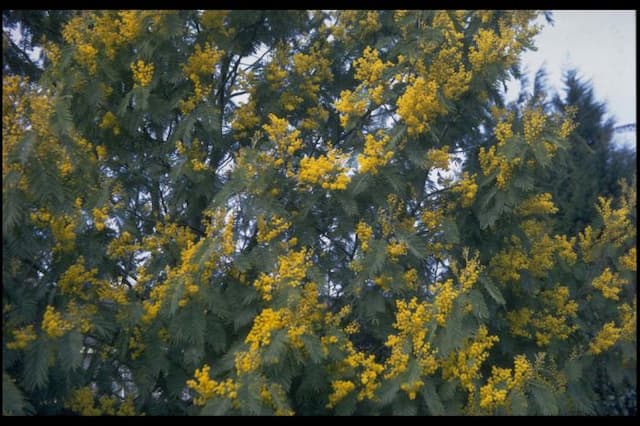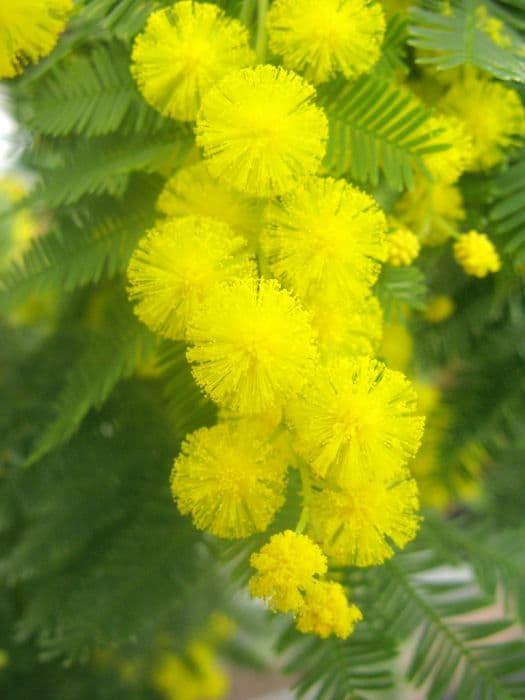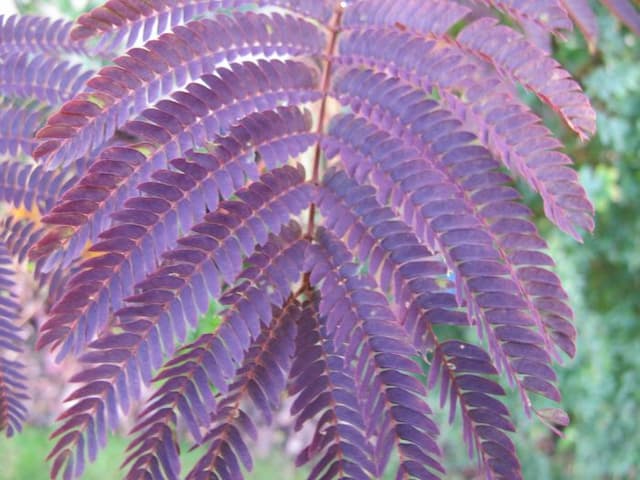Lobster Claw Clianthus puniceus 'Roseus'

ABOUT
Clianthus puniceus 'Roseus', commonly known as the "Pink Kaka Beak," is a captivating flowering plant known for its distinctive and ornamental attributes. The most striking feature of this plant is its clusters of large, pendulous, and beak-shaped flowers which are a soft pink hue. These floral displays hang elegantly from the branches, creating a remarkable visual impact. The foliage of the Pink Kaka Beak consists of bright green leaves that are pinnate, meaning they are composed of multiple small leaflets arranged on either side of a central stem, giving them a feathery appearance. The pairing of the lush green leaves with the charming pink flowers creates a beautiful contrast that can add interest to any garden setting. This plant is a perennial and is known to be rather showy, often used as a focal point in garden designs due to its unique flowering characteristics. The Pink Kaka Beak has the potential to bring a touch of exotic flair to landscapes, attracting attention with its ornate blooms that emerge typically in the spring and early summer months. The overall form of the Pink Kaka Beak is generally described as spreading and somewhat open, with a tendency to produce a decent amount of branches which allow the plant to display its flowers generously. Though resilient, it's important to note that this plant may need some support or shelter in certain environments, as its dramatic floral displays can be somewhat delicate. In conclusion, the Pink Kaka Beak's striking pink blossoms and complementary greenery make it a popular choice for gardeners looking to incorporate vivid colors and unique floral shapes into their outdoor spaces. Its appearance can provide a natural elegance and a splash of color that is particularly appealing during its blooming season.
About this plant
 Names
NamesFamily
Fabaceae
Synonyms
Kaka Beak, Parrot's Beak, Parrot's Bill, Lobster Claw, False Kowhai
Common names
Clianthus puniceus, Clianthus magnificus, Donia punicea, Donia speciosa, Swainsona novae-zelandiae.
 Toxicity
ToxicityTo humans
The most common common name for Clianthus puniceus 'Roseus' is Lobster claw. There is limited information regarding the toxicity of this plant to humans. However, as a general precaution, it is advised not to ingest any part of garden ornamental plants like the Lobster claw, as they may not have been evaluated for human consumption safety. If Lobster claw is indeed toxic and one ingests it, they may experience symptoms typical of plant poisoning such as nausea, vomiting, diarrhea, or abdominal pain. If you suspect poisoning, it is important to seek medical help immediately.
To pets
The common name for Clianthus puniceus 'Roseus' in reference to pets is Lobster claw. There is not much information readily available about the specific toxicity of Lobster claw to pets such as dogs and cats. Generally, many ornamental plants can be harmful to pets if ingested, and it's best to keep them out of reach. If a pet does consume Lobster claw and it is toxic, symptoms may include vomiting, diarrhea, drooling, or lethargy. If you notice these symptoms or suspect that your pet has ingested part of this plant, contact your veterinarian or an animal poison control center immediately.
 Characteristics
CharacteristicsLife cycle
Perennials
Foliage type
Evergreen
Color of leaves
Green
Flower color
Pink
Height
6 feet (1.8 meters)
Spread
6 feet (1.8 meters)
Plant type
Shrub
Hardiness zones
9
Native area
New Zealand
Benefits
 General Benefits
General Benefits- Aesthetic Appeal: The Clianthus puniceus 'Roseus', also known as the Pink Kaka Beak, offers a striking floral display with its pink, beak-shaped flowers, enhancing garden beauty.
- Wildlife Attraction: Its vibrant flowers attract pollinators such as bees and birds, supporting local ecosystems.
- Drought Tolerance: Once established, Pink Kaka Beak is relatively drought-tolerant, requiring less water and reducing the need for frequent irrigation.
- Coastal Resilience: It is suited to coastal conditions, tolerating salt spray and winds, making it ideal for seaside gardens.
- Erosion Control: The shrub can help stabilize soil and prevent erosion on slopes or banks with its root system.
- Fast Growing: Pink Kaka Beak tends to grow quickly, providing a rapid impact on landscaping and garden design.
- Easy Propagation: The plant can easily be propagated from cuttings, allowing gardeners to expand their plantings or share with others.
 Medical Properties
Medical PropertiesThis plant is not used for medical purposes.
 Air-purifying Qualities
Air-purifying QualitiesThis plant is not specifically known for air purifying qualities.
 Other Uses
Other Uses- Clianthus puniceus 'Roseus', commonly known as Lobster Claw, can be used in educational settings as a botanical specimen due to its unique flower shape which resembles a lobster's claw, providing a visual aid for studies in plant morphology.
- The bright and vibrant flowers of the Lobster Claw can serve as a natural dye source for fabrics, offering hues of pink and red.
- Lobster Claw can be used in xeriscaping, a landscaping method that reduces or eliminates the need for supplementary water, as it has drought-tolerant properties once established.
- The dense foliage of Lobster Claw provides a habitat and shelter for various species of birds, which can be beneficial for encouraging avian biodiversity in gardens.
- In coastal areas, Lobster Claw, with its tolerance to salt and winds, can be planted as a protective barrier for soil erosion control.
- Pruned branches of the Lobster Claw can be crafted into intricate floral arrangements or used as part of natural art installations due to their unique appearance.
- The plant's distinctive flowers can often be used in the horticultural trade as a parent in hybridization efforts to create new ornamental cultivars with unique characteristics.
- Lobster Claw can be incorporated into sensory gardens, where visitors can enjoy its soft leaves and striking flowers through touch and sight.
- Beekeepers may utilize Lobster Claw in their gardens as the plant's flowers are attractive to bees, aiding in the local bee population's health and pollination efforts.
- The wood from mature Lobster Claw plants might be used in crafting small wooden objects or as part of mixed-media artwork, although it is not commonly known for its timber value.
Interesting Facts
 Feng Shui
Feng ShuiThe Lobster claw is not used in Feng Shui practice.
 Zodiac Sign Compitability
Zodiac Sign CompitabilityThe Lobster claw is not used in astrology practice.
 Plant Symbolism
Plant Symbolism- Distinctiveness: Also known as Kakabeak, Clianthus puniceus 'Roseus' is recognized for its unique beak-shaped flowers and serves as a symbol of distinctiveness or standing out in a crowd.
- Attraction: The bright, showy colors of the Kakabeak flowers are symbolic of attraction and grabbing attention, similar to how flowers attract pollinators.
- Rarity: Kakabeak is a rare plant in the wild and thus often symbolizes rarity and preciousness, encouraging the protection of unique or endangered elements in our world.
- Survival: As a plant that can grow in tough environments, Kakabeak symbolizes resilience and the ability to thrive despite challenging conditions.
- Love and Affection: The vibrant red colors of the Kakabeak can also symbolize passion, deep love, and affection, drawing parallels to red roses which share a similar color palette and symbolism.
 Water
WaterThe New Zealand Kaka Beak should be watered deeply but infrequently, allowing the soil to become slightly dry between waterings. In general, watering about once a week during the growing season is sufficient, but this may vary depending on climate conditions and soil type, with adjustments needed during hot or dry spells. A good approach is to water with approximately 1-2 gallons every 7-10 days, ensuring that the water reaches the root zone. During winter, reduce watering since the plant will be dormant and requires less moisture. Make sure not to overwater, as the Kaka Beak does not like to sit in soggy soil.
 Light
LightThe New Zealand Kaka Beak thrives in full sun conditions where it can receive at least six hours of direct sunlight each day. A sunny spot in the garden that is well-exposed to natural light is ideal for this plant. However, it can tolerate some partial shade, especially in the hottest parts of the day or in very warm climates. Avoid deep shade as this can reduce flowering and may lead to leggy growth.
 Temperature
TemperatureThe New Zealand Kaka Beak prefers temperate climates and can tolerate temperatures down to about 25 degrees Fahrenheit though it is frost sensitive. The ideal temperature range for this plant is between 50 to 75 degrees Fahrenheit. Extreme cold and hot conditions should be avoided to protect the plant's health. In regions with very cold winters, it may require protection or need to be grown as a container plant that can be moved indoors.
 Pruning
PruningPruning the New Zealand Kaka Beak is important for maintaining a bushy and attractive shape, encouraging new growth, and increasing flowering. Prune after flowering has finished, typically in late summer or early autumn. Remove any dead or damaged branches, and cut back about a third of the plant to stimulate new growth. Regular pruning, done annually, also prevents the plant from becoming leggy.
 Cleaning
CleaningAs needed
 Soil
SoilThe Lobster Claw (Clianthus puniceus 'Roseus') prefers a well-draining soil mix with plenty of organic matter; a blend of loam, peat, and coarse sand is ideal. The soil pH best suited for the Lobster Claw is slightly acidic to neutral, ranging from 6.0 to 7.5.
 Repotting
RepottingLobster Claw plants should generally be repotted every 2-3 years to refresh the soil and provide room for growth. It may be less frequent for mature plants if they're not becoming pot-bound.
 Humidity & Misting
Humidity & MistingLobster Claw enjoys moderate to high humidity levels, ideally between 50-70%. They thrive in conditions that mimic their native coastal and forest environments.
 Suitable locations
Suitable locationsIndoor
Use bright indirect light and ensure humidity for indoor Lobster Claw.
Outdoor
Plant in a sheltered spot with morning sun and afternoon shade for outdoor Lobster Claw.
Hardiness zone
9-11 USDA.
 Life cycle
Life cycleThe Kaka Beak (Clianthus puniceus 'Roseus') begins its life cycle with seed germination, which requires scarification to break seed dormancy and mimic natural processes like passing through an animal's digestive system or being subjected to fire. Upon germination, the seedling grows rapidly, developing a root system and foliage. As it matures into a young plant, it requires full sun and well-drained soil to thrive, usually reaching its mature form within a few years. The Kaka Beak is known for its distinctive, rose-pink, beak-shaped flowers that appear mainly in spring, attracting pollinators such as birds and bees. Once pollinated, the plant produces seed pods, which mature and eventually split open to disperse seeds for the next generation. The plant is a perennial, so after flowering, it will go into a period of dormancy in winter before beginning a new growth cycle in spring.
 Propogation
PropogationPropogation time
Spring-Early Summer
The most popular method of propagation for the Lobster Claw, also known as Clianthus puniceus 'Roseus', is through seed sowing. To propagate Lobster Claw by seed, first, it's critical to collect ripe seeds from mature pods. Once collected, the hard seed coat requires scarification to improve water uptake and encourage germination. This is often done by gently nicking the seed coat with a knife or rubbing it with sandpaper. After scarification, the seeds are typically soaked in warm water for 24 hours to further soften the coat. They are then sown in well-draining soil at a depth of approximately 1/4 inch (about 6 millimeters), in a seed-raising tray or pots. Given the right conditions—light, warmth, and moisture—seeds usually germinate within 1 to 3 weeks. It's best to start this process in late winter or early spring to allow for a full growing season.









